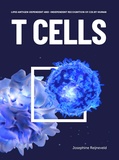Lipid antigen-dependent and -independent recognition of CD1 by human T cells

Reijneveld, Josephine Frederiek
- Promoter:
- Prof.dr C.A.C.M. (Cecile) van Els & prof.dr A.J. (Adri) Minnaard
- Co-promoter:
- Dr I. (Ildiko) van Rhijn
- Research group:
- Els
- Date:
- October 14, 2021
- Time:
- 14:15 h
Summary
Cluster of differentiation 1 (CD1) molecules are Major Histocompatibility Complex (MHC) class I-like proteins that present diverse lipid antigens to T cells instead of peptides. This thesis centers around the question what the biological function of the CD1 isoforms CD1b and CD1c is in T cell immunity. Part I of this thesis explores how CD1b and CD1c present lipid antigens from Mycobacterium tuberculosis to antibacterial T cells. Chapter 2 describes the total synthesis of three mycobacterial diacyltrehalose (DAT) lipids. The small differences in the chemical structure of the lipidic parts of DAT1, DAT2, and DAT3 led to drastic differences in binding by the innate immune receptor Mincle, which could only be activated by DAT3. In chapter 3 we investigated the recognition of mycobacterial DAT lipids by human T cell receptors. Whereas the Mincle receptor only recognizes DAT3, T cells follow a different pattern as observed by binding of DAT1- and DAT2- treated CD1b tetramers, but not DAT3- treated CD1b tetramers. Chapter 4 describes the immunological recognition of three different synthetic mycobacterial mannosyl phosphomycoketide (MPM) analogs designed to withstand hydrolysis to phosphomycoketide. One analog, MPM-3, was hydrolysis-resistant and recognized by human T cells that are cross-reactive to natural MPM. Part II of this thesis describes research on lipid antigen-independent recognition of CD1, also known as CD1 autoreactivity. CD1-mediated T cell autoreactivity has been shown previously, but it is unclear whether that represented a rare event revealed by the methods used in the past, or whether autoreactivity is common in the CD1 system. In chapters 5 and 6 tetramers were used to study CD1 autoreactivity patterns of T cells. Chapter 5 describes the discovery that CD1b is recognized by several human Vd1 gamma delta T cell receptors and stimulates autoreactive responses. The different gamma delta T cell receptors interacted with different surfaces of CD1b and showed different requirements for lipid antigens and co-recognition of butryophilin-like proteins. In chapter 6 we investigated the recognition of CD1c itself by human T cells. Tetramer binding and autoreactivity occurred with CD1c in complex with numerous, chemically diverse self-lipids that were fully seated within the antigen binding cleft, suggesting that the small lipid size is a determinant of autoreactive T cell responses via CD1c. In conclusion, this thesis focuses on recognition of the antigen presenting molecules CD1b and CD1c by the human immune system. Two types of T cell-CD1 interaction are covered here: 1) recognition of CD1 presented mycobacterial lipids by human T cells and 2) the recognition of the CD1 itself, independent of the lipid presented.